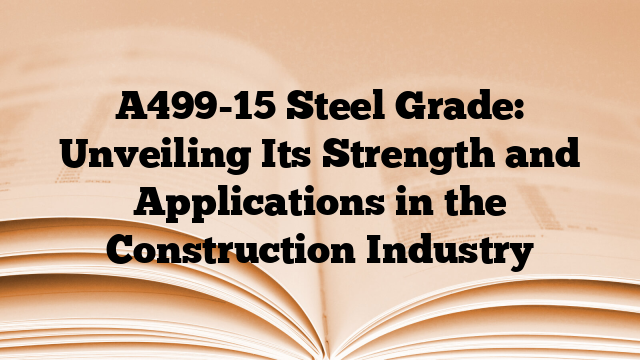Chemical Composition of A499-15 Steel Grade: Unveiling Its Strength and Applications in the Construction Industry
The chemical composition of A499-15 steel grade plays a crucial role in determining its strength and suitability for various applications in the construction industry. A499-15 steel is primarily composed of iron (Fe) and carbon (C), but it also contains other elements in varying amounts.
The main elements present in A499-15 steel grade include:
1. Carbon (C): Carbon is an essential element in steel as it improves its strength and hardness. The carbon content in A499-15 steel is typically within the range of 0.15-0.25%.
2. Manganese (Mn): Manganese is another important element in steel that enhances its toughness and hardenability. A499-15 steel grade usually contains manganese in the range of 0.80-1.10%.
3. Phosphorus (P): Phosphorus is a common impurity in steel, but it should be kept at a low level as it can reduce the toughness and weldability of the steel. The maximum phosphorus content in A499-15 steel is limited to 0.04%.
4. Sulfur (S): Sulfur also acts as an impurity in steel and can adversely affect its ductility and toughness. In A499-15 steel grade, the sulfur content is limited to a maximum of 0.05%.
5. Silicon (Si): Silicon is added to steel to improve its strength and enhance its resistance to oxidation. The silicon content in A499-15 steel grade is typically around 0.80%.
6. Copper (Cu): Copper is sometimes added to steel to improve its corrosion resistance. However, in A499-15 steel grade, the copper content is negligible.
Overall, the chemical composition of A499-15 steel grade ensures a balance between strength, toughness, and weldability, making it suitable for various construction applications.
Mechanical Properties of A499-15 Steel Grade: Unveiling Its Strength and Applications in the Construction Industry
The mechanical properties of A499-15 steel grade determine its strength, durability, and suitability for different construction applications. These properties are influenced by factors such as the chemical composition of the steel and the heat treatment it undergoes.
Some of the important mechanical properties of A499-15 steel grade include:
1. Tensile Strength: The tensile strength of A499-15 steel measures its ability to withstand pulling forces without breaking. The minimum tensile strength for A499-15 steel is typically around 60,000 psi (pounds per square inch).
2. Yield Strength: The yield strength of A499-15 steel is the maximum stress that it can withstand without experiencing permanent deformation. The minimum yield strength for A499-15 steel is usually around 36,000 psi.
3. Elongation: Elongation measures the amount of deformation or stretching that A499-15 steel can undergo before fracturing. The minimum elongation for A499-15 steel is typically around 25%.
4. Hardness: Hardness refers to the ability of A499-15 steel to resist indentation, scratching, or penetration. The hardness of A499-15 steel can vary depending on the heat treatment applied, but it is generally within the range of 180-220 Brinell hardness number (BHN).
These mechanical properties make A499-15 steel grade suitable for a wide range of construction applications. It can be used in the construction of buildings, bridges, highways, and various structural components.
Standard Number of A499-15 Steel Grade: Unveiling Its Strength and Applications in the Construction Industry
A499-15 is the standard number that identifies the specific requirements and specifications for the A499-15 steel grade. The standard number ensures consistency, quality control, and compatibility of the steel in the construction industry.
The standard number A499-15 provides details on various aspects of the steel, including its chemical composition, mechanical properties, heat treatment, testing methods, and dimensions. It serves as a guideline that manufacturers and users of A499-15 steel grade can refer to for ensuring compliance and consistency in their products and projects.
Complying with the standard number A499-15 ensures that the A499-15 steel grade meets the necessary quality and performance requirements for its intended applications in the construction industry. It also facilitates communication and understanding between manufacturers, suppliers, contractors, and engineers involved in the construction projects.

